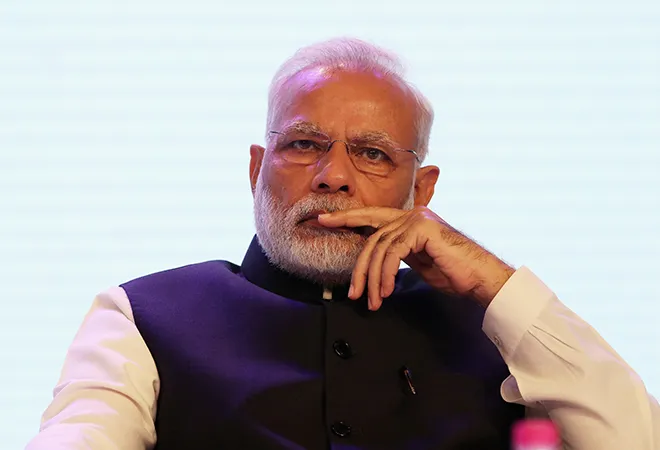A week into Narendra Modi’s second term as India’s prime minister, he has already signaled his foreign policy vision for the next several years. On 30 May, he named Subrahmanyam Jaishankar to his cabinet. Jaishankar will serve as the powerful minister of external affairs. Typically, the post would go to a high-ranking party member or political ally. But Jaishankar, a former foreign secretary, is a technocrat. One of the most respected foreign service officers in recent times — he was India’s longest-serving envoy to Beijing, an ambassador to the United States, and a key player in the successful conclusion of the US-India civil nuclear deal under Modi’s predecessor, Manmohan Singh — he is not even a member of Modi’s Bharatiya Janata Party (BJP). His appointment underscores Modi’s penchant for boldness, especially when the stakes are high.
During Modi’s first term, Jaishankar was instrumental in turning the prime minister’s foreign policy vision into actionable policy. For too long, Modi believed, India had behaved as a balancing power in the world order rather than as one that proactively shapes global rules and norms. It was Jaishankar who tried to shape Indian foreign-policy priorities accordingly. As the foreign secretary, not only did he recalibrate ties between the United States and India, but also helped resolve the 2017 Doklam crisis between India and China, in which the armies of the two Himalayan neighbours stood face to face at the border of India, Bhutan, and China for more than two months.
By elevating Jaishankar to minister of external affairs, Modi has made it clear that, in the coming years, India will prioritise foreign policy. On the global stage, this comes at a time when escalating tensions between the United States and China are shaking up the world order. At the same time, US-Indian relations may hit a rough patch over growing disagreements on trade-related issues. The decision by US President Donald Trump’s administration to end tariff exemptions on $5.6 billion worth of Indian exports is just the tip of the iceberg. Although New Delhi has said it “will continue to build on our strong ties with the US, both economic and people-to-people,” it is clear that tough times lie ahead. As Trump enters election mode, he will continue to focus on trade issues around the world. With his understanding of the American domestic political landscape and his past experience navigating it, Jaishankar is seemingly well placed to pragmatically manage growing US-India tensions.
Modi has made it clear that, in the coming years, India will prioritise foreign policy.
Jaishankar’s entry into the cabinet also signals Modi’s desire to shift India’s regional outlook. Last week, Modi invited representatives from the Bay of Bengal Initiative for Multi-Sectoral Technical and Economic Cooperation (BIMSTEC) member states to attend his swearing-in ceremony. BIMSTEC includes Bangladesh, India, Myanmar, Sri Lanka, Thailand, Nepal, and Bhutan, and it has been gaining prominence in Indian foreign policy over the last few years. More than two decades old, today it covers around 21 percent of the world’s population and a combined gross domestic product of more than USD 2.5 trillion. But few had heard of BIMSTEC before Modi made it central to his government’s regional outreach.
Indeed, BIMSTEC has largely replaced the South Asian Association for Regional Cooperation (SAARC), which includes Afghanistan, Bangladesh, Bhutan, India, the Maldives, Nepal, Pakistan and Sri Lanka, and whose representatives were the guests of honour at Modi’s last inauguration. The shift signals that the prime minister may have given up on engaging Pakistan. (When Pakistani Prime Minister Imran Khan called Modi after his recent victory, Modi’s response suggested that New Delhi would respond to Pakistani overtures if it sees substantive shifts in Pakistan’s policy on terrorism.)
Channeling India’s regional foreign policy through BIMSTEC underlines Modi’s desire to focus on the country’s eastern frontier.The Bay of Bengal connects India to its eastern neighbours, not only to its traditional South Asian partners such as Bangladesh, Bhutan, Nepal, and Sri Lanka, but also to Southeast Asia via Myanmar and Thailand. By doing this, Modi has tried to redefine India’s strategic periphery, reimagining the country’s neighbourhood on more favourable terms.
Channeling India’s regional foreign policy through BIMSTEC underlines Modi’s desire to focus on the country’s eastern frontier.
Back in 2014, at a SAARC summit in Kathmandu, Modi suggested that opportunities for regional cooperation would be realised “through SAARC or outside it.” When his initial outreach to Pakistan failed to yield any substantive change in Pakistan’s policy, his government began to emphasise the importance of BIMSTEC. To some extent, that paid off; some of its countries gave support to New Delhi’s call for a boycott of the SAARC summit scheduled in Islamabad in November 2016 after India blamed Pakistan for terror attacks in Kashmir in September that year.
As India focuses on the Indo-Pacific, BIMSTEC, if creatively engaged, can be an important platform for India to enhance its profile in East and Southeast Asia. Even as India seems to engage with China at a time of geopolitical turbulence, Modi would like to expand India’s profile in the wider Indo-Pacific and carve out a stable balance of power in the region. Doing so will be important if India wants recognition as a major power in its own right and not merely as a balancer.
At the start of his second term, Modi is indicating that he is serious about the foreign policy outlined in his first term. And by entrusting Jaishankar with this assignment, he will likely see it carried through.
This commentary originally appeared in Foreign Policy.
The views expressed above belong to the author(s). ORF research and analyses now available on Telegram! Click here to access our curated content — blogs, longforms and interviews.

